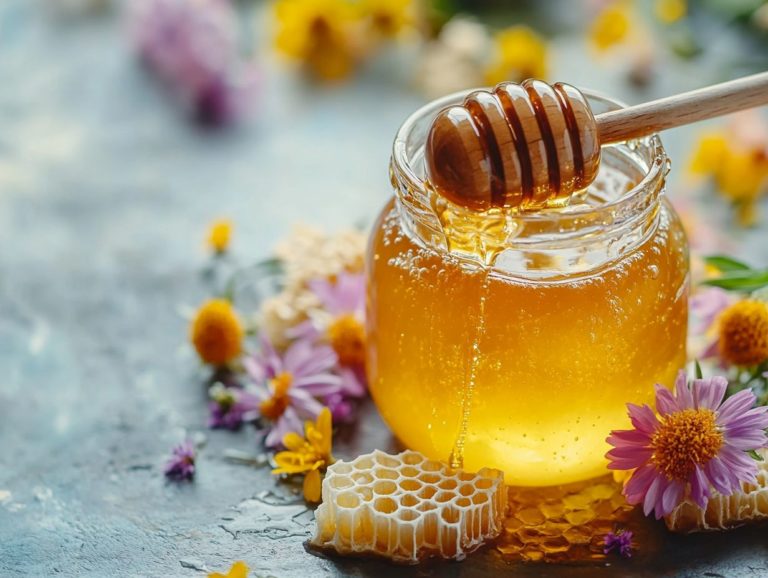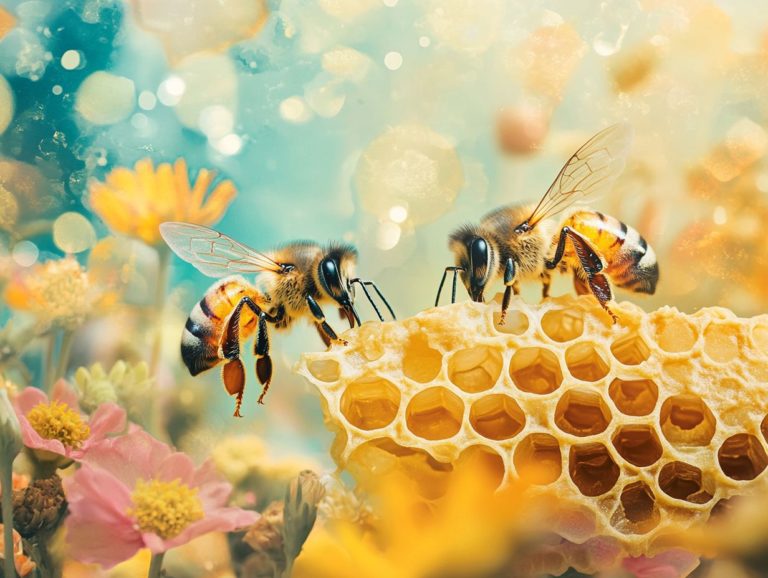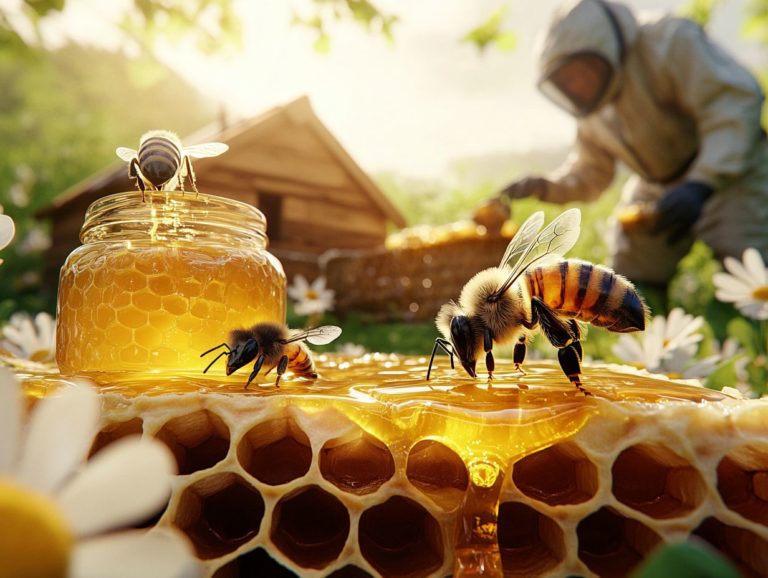How to Store Honey Properly After Harvesting
Honey is not merely a delightful sweetener; it s a versatile ingredient steeped in history and brimming with health benefits. From the preparation to the final jarring, each step adds to its unique characteristics. To truly savor its myriad qualities, proper storage becomes essential.
This article delves into the essence of honey, exploring how it’s harvested from colonies and why storage is crucial for maintaining its quality. It offers indispensable tips on the best practices for keeping honey fresh, highlights the signs of spoilage to be vigilant for, and presents creative ways to utilize honey that may have reached its prime, such as making mead or using it in Christmas recipes.
Discover the amazing uses of this golden elixir today, whether it’s raw honey, local honey, or a unique honey variety like OSR honey!
Contents
Key Takeaways:
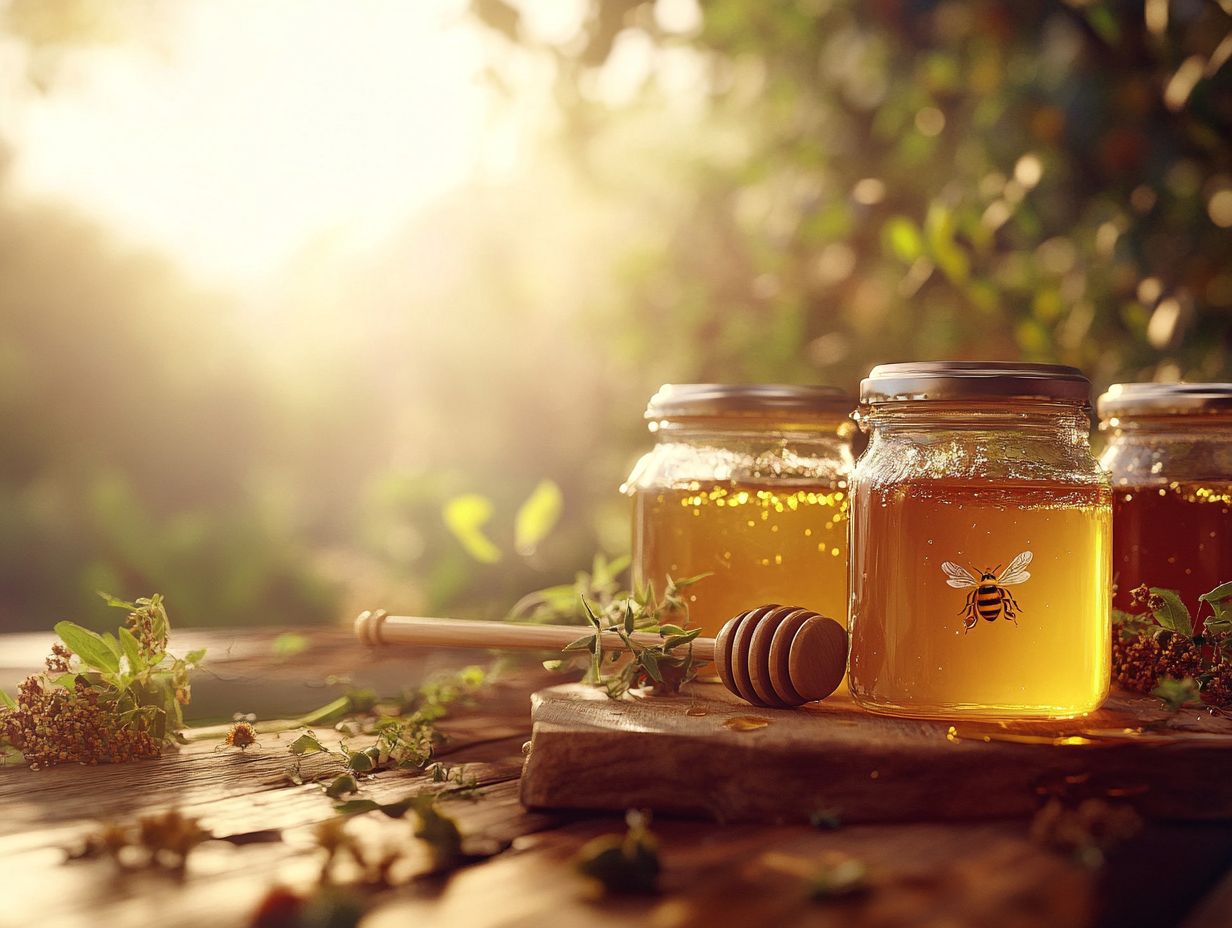
- Proper storage of honey is crucial for its quality and longevity.
- Choose a container that is airtight, kept in a cool and dry place, and away from direct sunlight.
- If honey has gone bad, it can still be used as a natural sweetener, in skincare products, or for baking and cooking.
What is Honey?
Honey is a delightful, viscous substance crafted by bees through their intricate process of collecting and transforming nectar. This natural sweetener is not just celebrated for its distinct flavors but also for its potential health benefits and remarkable versatility in the kitchen. Home printed labels can add a personal touch when sharing your honey with others.
Sourced from various floral origins, including apple trees and oilseed rape (OSR), honey presents a fascinating array of tastes, colors, and textures. Each jar is a unique reflection of its regional blossoms. You ll find that beekeepers play an essential role in this enchanting production, nurturing colonies that yield an average hive output measured in pounds. According to a recent BBKA survey, these efforts contribute significantly to the local economy and biodiversity.
How is Honey Harvested?
The harvesting of honey is a careful method that demands your attention and care, involving several steps to ensure that the honey you extract is of the highest quality and ready for consumption. This process, known as honey production, starts with the careful handling of the hives in your apiary.
You begin by carefully inspecting your colonies to determine the optimal moment for extraction, typically when the honeycombs are full and capped. The extraction process involves using specific tools to separate the honey from the wax combs, followed by jarring and bottling to preserve its natural flavors and aromas. For instance, the National Honey Board provides guidelines to help beekeepers in this crucial phase.
Understanding crystallization is important because it affects the honey’s texture and quality. It is the process where honey thickens and becomes grainy, depending significantly on the glucose content of the honey, which varies between different types of floral sources.
Why is Proper Storage Important?
Proper storage is essential for preserving the quality and longevity of honey. Factors like temperature and humidity are crucial for maintaining honey’s natural properties. Poor storage can result in crystallization or spoilage, diminishing its natural sweetness and nutritional benefits.
The correct storage methods ensure your honey remains at its best, regardless of whether you’re dealing with seasonal honey like spring apricot honey or winter heather honey. Storing honey properly means that each jar, whether it s for everyday use or a special occasion like Christmas, remains delicious and beneficial.
By familiarizing yourself with the best practices for honey storage, you can savor the rich flavors of your honey for extended periods. This ensures that each jar remains fresh and delightful, whether you prefer liquid honey or soft set honey.
What Factors Can Affect Honey Storage?
Several factors can significantly influence how you store honey, impacting its quality, flavor, and shelf life. Consider critical elements such as temperature fluctuations, high humidity levels, and light exposure to prevent undesirable changes in texture and composition.
According to research published in Pharmacognosy Res, improper storage can lead to the degradation of honey’s healthy components. High temperatures can speed up the crystallization process, where honey turns from a liquid to a solid. Excessive moisture can lead to fermentation, compromising the quality of the honey.
Beekeepers in regions like Fife, Scotland, often face these challenges and have developed specific techniques to mitigate them. Light can degrade honey s flavors and nutrients. Store honey in a cool, dark place to keep it at its best.
Regularly check your stored honey for signs of fermentation or crystallization. Taking these precautions will help you maintain its premium quality. This practice is recommended by the National Honey Board to ensure top-notch honey quality.
What is the Best Way to Store Honey?
Properly storing honey is crucial to keep it delicious and fresh! Adhering to a few best practices can yield optimal results.
First, selecting the right container is essential. Glass jars are the best choice for storing honey because they keep it fresh and flavorful. Airtight containers effectively prevent moisture from seeping in and help maintain the honey s natural flavor and texture.
Position your honey in a cool, dry location, away from direct sunlight, to safeguard it from degradation. This ensures that it remains in peak condition, whether you re dealing with raw honey or high-quality honey sourced from local beekeepers.
1. Choosing the Right Container
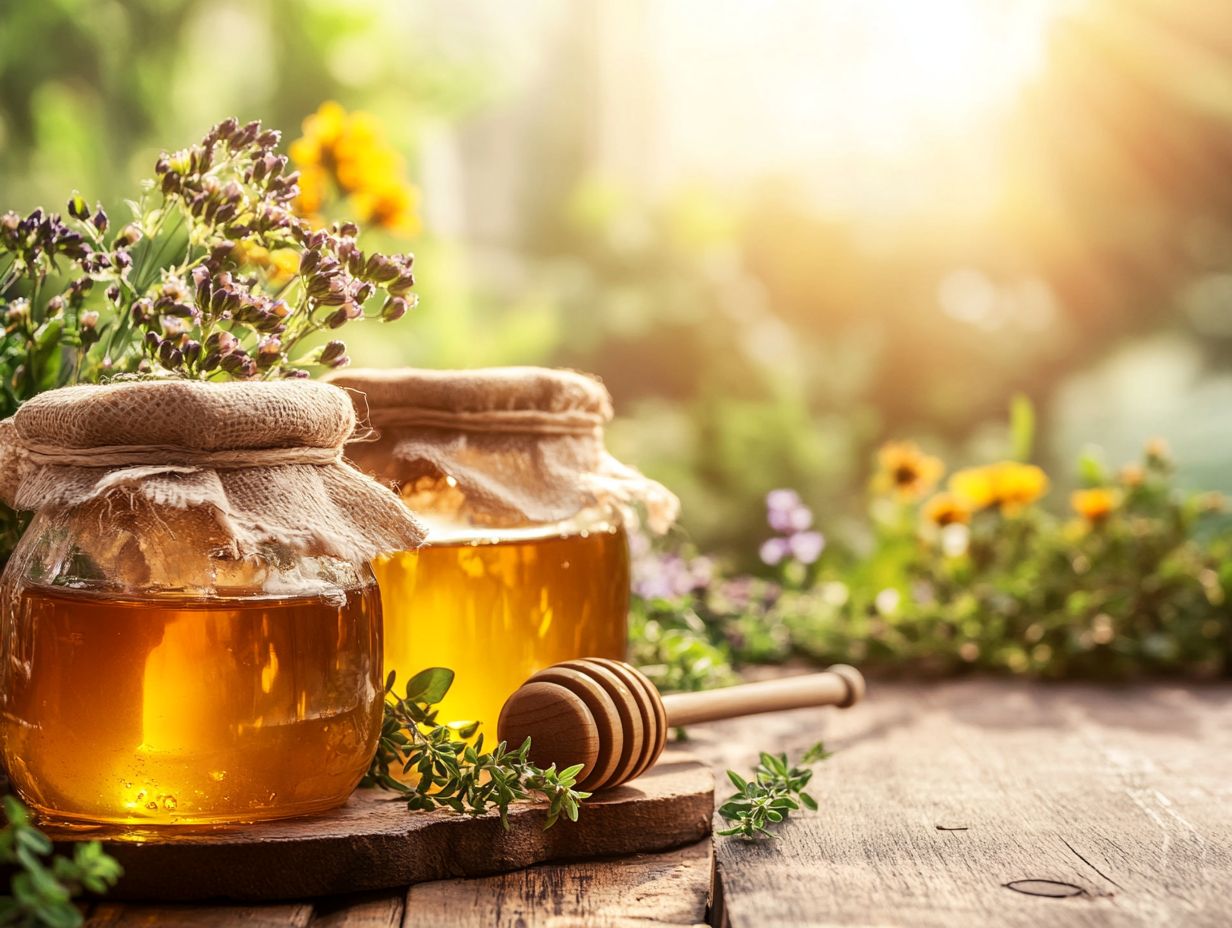
Choosing the right container for honey storage is essential for maintaining its quality and preventing spoilage. Opt for airtight containers, as they effectively seal in the honey’s natural moisture and flavor while protecting it from unwanted odors or moisture from the environment.
Many beekeepers favor glass jars not only do they preserve the honey’s integrity, but they also create an attractive display in your kitchen, especially when adorned with custom labels. Some even prefer jars made from amber glass, which further protects the honey from light exposure.
Several options are available, including plastic containers, stainless steel tanks, and ceramic jars, each bringing unique benefits and drawbacks. While plastic may be lightweight and convenient, it often lacks the same level of airtightness as glass, which can lead to a quicker decline in quality over time. Stainless steel tanks are often used for bulk storage in commercial honey production.
Using improper storage materials can introduce contaminants or even cause the honey to ferment, resulting in off-flavors and a compromised product. Therefore, selecting high-quality, airtight storage solutions is vital for anyone looking to preserve the distinct characteristics of honey for an extended period. Whether you’re storing local honey, raw honey, or a unique honey variety, the right storage is crucial.
2. Keeping Honey in a Cool and Dry Place
Keeping honey in a cool, dry place is crucial for preserving its great taste and preventing spoilage over time. Create ideal storage conditions by maintaining a stable, cool temperature below room temperature. Temperature fluctuations can lead to crystallization and a decline in honey quality, which is the last thing you want.
A pantry or cupboard, away from heat sources, serves as an excellent refuge. It protects your honey from temperature extremes that can compromise its delightful flavor and texture. A cool, dark place ensures the honey remains as intended, whether it s a jar from a local beekeeper or a high-quality honey purchased online.
Aim for a temperature range between 50 F and 70 F (10 C to 21 C) for optimal storage. Be mindful of humidity and direct sunlight. These factors can significantly shorten honey’s longevity. For the best results, opt for an opaque container to shield the honey from light, which can trigger undesirable chemical reactions.
Regularly inspect your storage area for any signs of moisture. Ensure the jars are tightly sealed to prevent air from sneaking in, as it can introduce bacteria and lead to fermentation.
By taking these thoughtful precautions, you can relish the rich, complex flavors of honey for an extended period. Protect your honey and savor its sweetness for years!
3. Avoiding Direct Sunlight
Avoiding direct sunlight is essential for preserving your honey because exposure to UV rays can negatively affect its quality and flavor. When honey is left in the sun for too long, it can trigger chemical reactions that degrade its natural compounds. This leads to spoilage and a loss of the beneficial properties you love.
To keep your honey lasting longer and maintain that rich taste, store it in opaque containers or in dark spaces that shield it from light. Research shows that sunlight can break down the antioxidants and phenolic compounds in honey. These compounds are vital for its impressive health benefits. Antioxidants help keep your body healthy by fighting off harmful substances.
To tackle this issue, consider using containers specifically designed to block UV rays this can be incredibly effective. Opt for storage solutions made from materials like amber glass or certain plastics that preserve honey s unique qualities and extend its shelf life.
Storing honey in a cool, dark pantry rather than near the stove or window will protect it from temperature fluctuations and light exposure. This ensures that this sweet treat remains as rich and delicious as intended for an extended period. Some popular brands on Amazon offer containers specifically designed for optimal honey storage.
4. Using Airtight Containers
Using airtight containers is one of the most effective strategies to preserve honey and safeguard its unique qualities over time. These containers prevent moisture from sneaking in and shield the honey from absorbing unwanted odors that could alter its flavor. This method of storage is especially vital for raw honey, which is more sensitive to environmental changes than processed varieties.
Whether you are storing local honey or a high-quality honey like Heinz Honey, using the correct containers makes a significant difference. Various types of airtight containers each offer their own distinct advantages.
For example, glass jars are not only non-reactive but also aesthetically pleasing, allowing you to admire the honey s rich color and texture. On the flip side, plastic containers are lightweight and typically come with tight-sealing lids, ensuring a dependable barrier against air and moisture. Many honey enthusiasts in England and Scotland prefer these containers.
Metal tins, on the other hand, are perfect for long-term storage. They resist light and help maintain consistent temperatures. Regardless of the type you choose, the sealing mechanisms of these containers are crucial for extending the shelf life of honey. Start storing your honey correctly today to enjoy its rich flavors longer!
How Long Can Honey Be Stored?
The shelf life of honey is impressively lengthy, enabling you to store it for years without notable deterioration, provided it s kept in the right conditions. According to the BBKA survey, honey stored properly can last for decades.
Raw honey, celebrated for its natural enzymes and nutritional benefits, boasts an indefinite shelf life thanks to its low moisture content and high acidity.
While processed honey also enjoys a long lifespan, it may undergo subtle changes in flavor and texture over time, particularly if not stored properly. Therefore, grasping the nuances of honey s shelf life is essential for you as a discerning consumer.
1. Shelf Life of Raw Honey
The shelf life of raw honey is truly remarkable. It often lasts indefinitely when stored correctly due to its natural composition that inhibits bacterial growth. With its low moisture content and acidity, raw honey creates an environment that is decidedly unfriendly to microorganisms, allowing it to remain consumable for many years.
While it doesn t spoil, you may notice crystallization, which can change its texture but does nothing to compromise its safety or flavor. This is especially true for honey sourced from Fife or Scottish regions.
This longevity is due to enzymes like glucose oxidase, which produces hydrogen peroxide and further deters microbial growth. The high sugar content also plays a crucial role, as sugars naturally draw moisture away from bacteria. If you encounter crystallization, don t worry simply warm the jar gently in a water bath or use your microwave on low heat, taking care not to exceed 104 F (40 C) to preserve all its beneficial qualities!
It s a straightforward yet effective way to maintain that smooth texture while savoring all the natural goodness of raw honey.
2. Shelf Life of Processed Honey
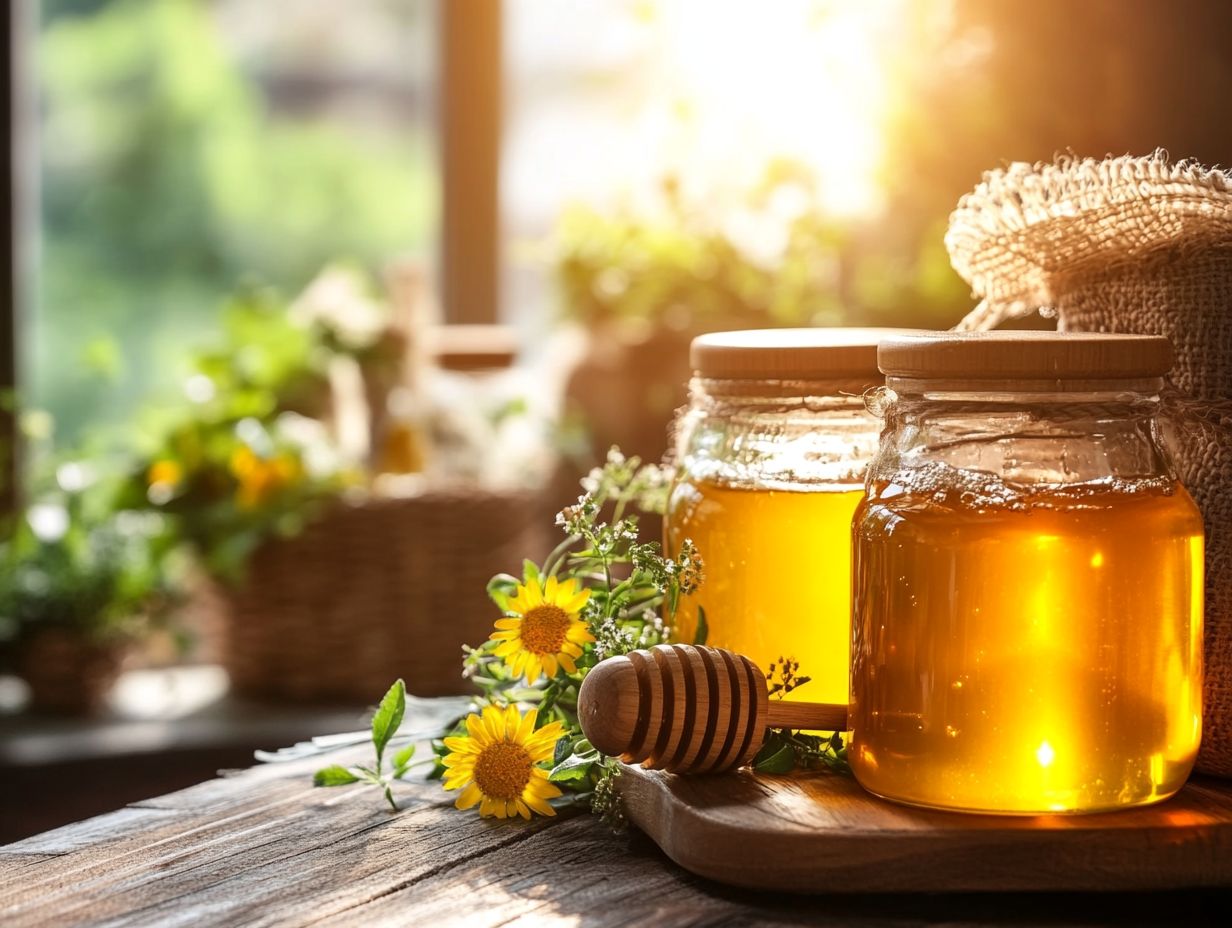
Processed honey generally boasts a shelf life of one to three years, a timeframe that hinges on both how you store it and the type of processing it undergoes. Unlike its raw counterpart, processed honey is subjected to heating and filtering, which can influence its nutritional qualities and flavor as time goes by.
To truly grasp the nuances of shelf life, it s important to understand that pasteurization a process of heating to kill bacteria eliminates yeast and bacteria, potentially extending honey’s longevity. However, this process can also diminish some of the beneficial enzymes and antioxidants that make honey so special.
Filtering, on the other hand, removes particulates and impurities, enhancing clarity but sometimes sacrificing the richness of flavor. To maximize the shelf life of your processed honey, keep it tightly sealed in a cool, dark place. Avoid exposing it to sunlight and refrain from introducing moisture, as this can lead to fermentation. By following these simple yet effective guidelines, you can savor the sweet benefits of processed honey for years to come!
What are the Signs of Spoiled Honey?
Identifying signs of spoiled honey is essential for you as a consumer, ensuring that you enjoy only the finest quality honey while sidestepping any potential health risks. While honey doesn t spoil in the conventional sense, it can show signs of degradation. Look out for unusual crystallization, changes in texture, and any hints of moisture or fermentation. Recognizing these indicators is crucial for maintaining the quality of your honey and ensuring it remains safe for consumption.
One of the primary signs to watch for is the formation of excessive crystals, which may suggest that the honey has been stored improperly or has absorbed moisture. If your honey appears darker than usual or has an off-putting smell, these could be warning signs that it s beginning to ferment.
Texture matters too; pure honey should glide smoothly and be viscous, whereas a gritty or grainy texture might indicate deterioration. Should you notice any of these signs, it s wise to reassess the storage conditions and consider discarding the honey to protect your health.
How Can You Tell If Honey Has Gone Bad?
Determining whether your honey has gone bad requires a keen eye for its physical characteristics and any notable shifts in smell or taste. If your honey has absorbed moisture, you might notice a fermented smell or even bubbling. These are clear signs that it has begun to ferment and is no longer safe for consumption. Drastic changes in color or an unusual odor can also indicate that the quality of the honey has deteriorated. In such cases, it s best to part ways with it. Studies in Pharmacognosy Res highlight these indicators.
You can easily assess honey’s purity and freshness with a simple water test. Just drop a spoonful into a glass of water. If it dissolves quickly, it may contain added sugars, so treat it with skepticism. Fresh honey typically clumps and settles at the bottom, a charming characteristic that speaks to its quality.
Honey stored in the right conditions cool, dry places will have a longer shelf life. Crystallization means that honey has formed sugar crystals, which is normal and not harmful; it s just nature taking its course. However, if you notice a strange consistency or an off-putting scent, don t hesitate to toss it.
Being vigilant about your honey’s appearance and aroma is essential for ensuring both safety and enjoyment.
What Are the Different Ways to Use Spoiled Honey?
Even spoiled honey has a range of alternative uses that can provide you with valuable benefits, particularly in home remedies and cooking.
While it may no longer be fit for consumption, it can still function as a natural sweetener in recipes where flavor is less of a concern. Its antibacterial properties make it a valuable ingredient in skincare products, soothing and hydrating the skin, despite its less-than-pristine condition. During events like Christmas, spoiled honey can be repurposed in creative ways.
1. Use as a Natural Sweetener
Using spoiled honey as a natural sweetener is a smart way to repurpose it in recipes where optimal flavor is not crucial. For example, when you use it in baked goods or marinades, the sweetness can beautifully complement other flavors. This lets you minimize waste while still achieving a delightful taste. Get creative with your cooking! Unique flavor combinations await you!
Consider adding it to a savory soy sauce marinade for chicken or tofu, blending in spices like garlic and ginger to craft a rich glaze. Alternatively, using it in banana bread or oatmeal cookies can elevate the overall flavor profile since the other ingredients tend to mask any subtle off notes in the honey.
Balancing the sweetness with ingredients like dark chocolate or tart fruits, such as cranberries or apples, invites creative experimentation. You can transform what was once considered unfit for consumption into a valuable culinary asset.
2. Use in Skincare Products
Spoiled honey can still be a remarkable addition to your DIY skincare arsenal, thanks to its natural antibacterial properties. These make it ideal for addressing minor skin concerns. By incorporating spoiled honey into your face masks or scrubs, you can enjoy its moisturizing benefits while minimizing waste. This clever approach not only repurposes honey that would otherwise be tossed aside but also offers natural advantages for your skin’s health.
Its unique ability to retain moisture makes it a fantastic component for hydrating treatments, leaving dry skin feeling luxuriously supple. You can easily mix it with ingredients like yogurt and oats to whip up a soothing face mask that calms irritated skin. Alternatively, combine it with olive oil and sugar for a gentle exfoliating scrub that brightens your complexion.
The antioxidants present in honey, even in its spoiled state, continue to shield your skin from environmental stressors while promoting a radiant glow.
By weaving these simple DIY recipes into your skincare routine, you can truly maximize the potential of spoiled honey. Transform what could have been waste into a delightful opportunity for self-care.
3. Use for Baking and Cooking
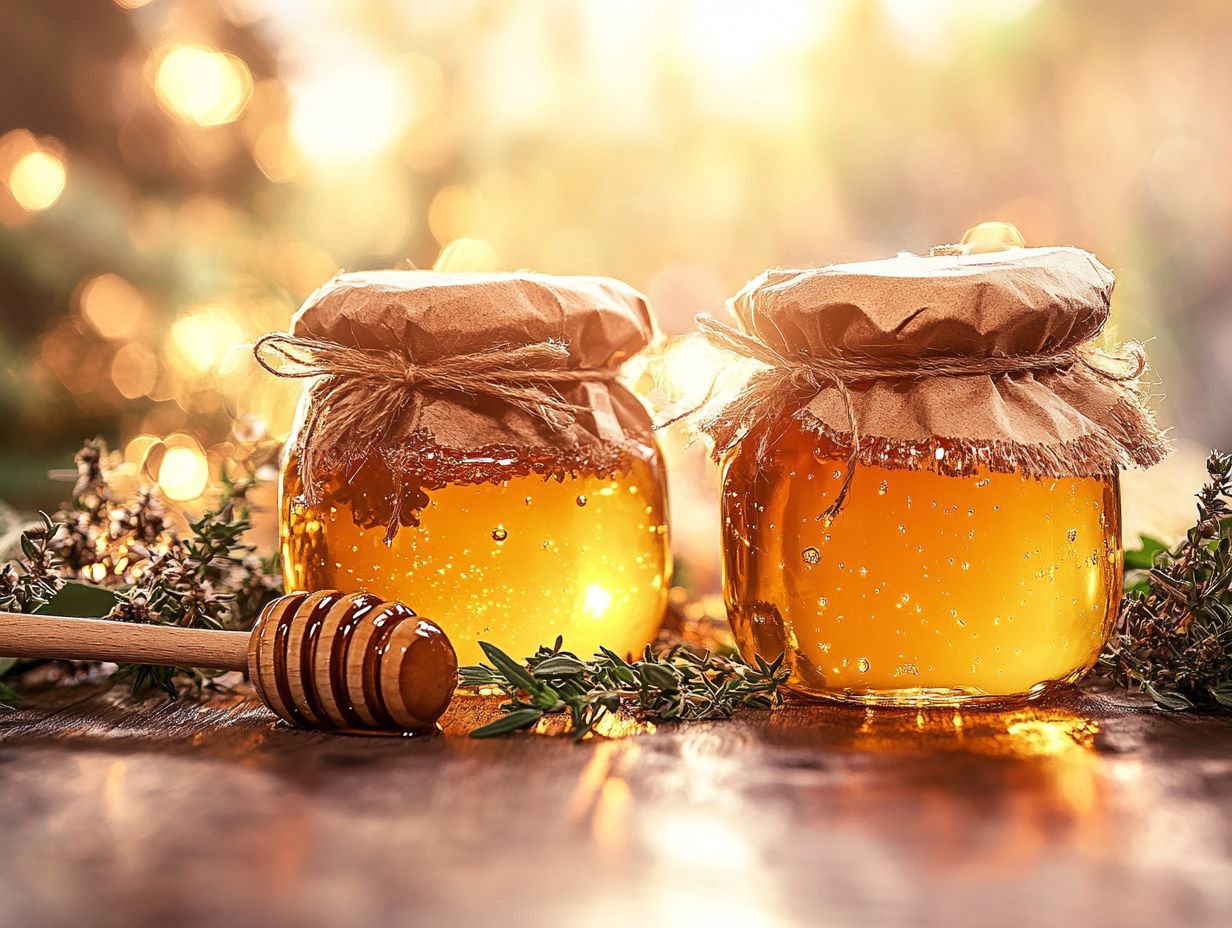
Using spoiled honey in your recipes is a smart way to reduce waste and enjoy its sweetness. You can add it to breads, muffins, and various savory dishes, where the unique flavor of honey improves the overall taste. This versatility opens the door for creativity in your kitchen, allowing even honey that has seen better days to find new life in a variety of culinary applications.
For instance, consider using it in marinades for meats and vegetables. The natural sweetness pairs beautifully with herbs and spices, creating a delightful balance. In dressings, mixing spoiled honey with mustard and vinegar can yield an unexpected yet pleasing flavor combination. You might also think about incorporating it into homemade granola bars or energy bites, providing a chewy texture alongside nuts and dried fruits.
This Christmas, elevate your festive dishes with a delightful touch of honey!
The slight fermentation in older honey adds a rich flavor to glazes or sauces, inviting you to experiment and transform what might appear as waste into high-quality delights. Some gourmet chefs from Fife in Scotland are known to use these techniques.
Frequently Asked Questions
What is the best way to store honey after harvesting?
The best way to store honey is in an airtight container at room temperature. Make sure the container is clean and dry.
Can I store honey in the refrigerator?
It is not recommended to store honey in the refrigerator as it can cause the honey to crystallize and change its texture and taste.
How long can I store honey for?
Honey can be stored for a very long time, even years, as long as it is kept in a sealed container. However, it is recommended to consume honey within 2 years for optimal taste and quality.
What is the ideal temperature for storing honey?
The ideal temperature for storing honey is between 70-80 degrees Fahrenheit. Avoid extreme temperatures as they can affect the quality of the honey.
Can I store honey in plastic containers?
No, it is not recommended to store honey in plastic containers as it can absorb chemicals from the plastic and affect the taste and quality. Glass or stainless steel containers are a better choice.
Do I need to store honey in a dark place?
Yes, it is best to store honey in a cool, dry, and dark place to prevent it from crystallizing and maintain its flavor and color.

